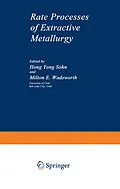Computer technology in the past fifteen years has essentially rev olutionized engineering education. Complex systems involving coupled mass transport and flow have yielded to numerical analysis even for relatively complex geometries. The application of such technology together with advances in applied physical chemistry have justified a general updating of the field of heterogeneous kinetics in extractive metallurgy. This book is an attempt to cover significant areas of extrac tive metallurgy from the viewpoint of heterogeneous kinetics. Kinetic studies serve to elucidate fundamental mechanisms of reac tions and to provide data for engineering applications, including improved ability to scale processes up from bench to pilot plant. The general theme of this book is the latter-the scale-up. The practicing engineer is faced with problems of changes of order of magnitude in reactor size. We hope that the fundamentals of heterogeneous kinetics will provide increasing ability for such scale-up efforts. Although ther modynamics is important in defining potential reaction paths and the end products, kinetic limitations involving molecular reactions, mass trans port, or heat flow normally influence ultimate rates of production. For this reason, rate processes in the general field of extractive metallurgy have been emphasized in this book.
Inhalt
1. Fundamentals of the Kinetics of Heterogeneous Reaction Systems in Extractive Metallurgy.- 1.1. Elementary Steps.- 1.1.1. Mass Transfer between a Solid Surface and a Fluid.- 1.1.2. Diffusion of Fluid Species through the Pores of a Solid.- 1.1.3. Intrinsic Kinetics of Heterogeneous Reactions on Solid Surfaces.- 1.1.4. Heat Transfer between a Solid Surface and a Moving Fluid Stream.- 1.1.5. Conduction of Heat in Porous Solids.- 1.1.6. Summary.- 1.2. Reaction of a Single Nonporous Particle.- 1.2.1. Reactions in Which No Solid Product Layer Is Formed.- 1.2.2. Reactions in Which a Product Layer Is Formed.- 1.2.3. Nonisothermal Reactions in Shrinking-Unreacted-Core Systems.- 1.2.4. Summary and Comments.- 1.3. Reaction of a Single Porous Particle.- 1.3.1. Reactions in Which No Solid Product Is Formed.- 1.3.2. Reactions in Which a Product Layer Is Formed.- 1.3.3. Concluding Remarks.- 1.4. Reactions between Two Solids Proceeding through Gaseous Intermediates.- 1.4.1. Formulation of Model.- 1.4.2. Results.- 1.4.3. Discussion.- 1.5. Notation.- References.- 2. Rate Processes in Multiparticle Metallurgical Systems.- 2.1. General Approach to Describing Rate Processes in Multiparticle Systems.- 2.1.1. Introduction.- 2.1.2. Motivation.- 2.1.3. Particle Characterization.- 2.1.4. Representation of Property Distributions.- 2.1.5. Population-Balance Framework.- 2.1.6. Application of Population Balance to Extractive Metallurgical Systems.- 2.1.7. Summary and Conclusions.- References.- 2A. Chemical Process Analysis and Design for Multiparticle Systems.- 2A.1. Introduction.- 2A.2. The Concept of General Reactor Scale-up Criteria.- 2A.2.1. Particle Phenomenological Kinetics.- 2A.2.2. Rate-Controlling Steps in Particle Reactions.- 2A.2.3. Particle Size Distribution.- 2A.2.4. Residence Time Distribution in the Reactor.- 2A.3. Computed Dimensionless Design Curves.- 2A.4. Application of F Curves in Process Design.- 2A.4.1. Determining the Kinetic Data.- 2A.4.2. Scale-up.- 2A.4.3. Discussion.- 2A.5. Application Examples.- References.- 3. Hydrometallurgical Processes.- Sec. 3.1. Milton E. Wads worth.- Sec. 3.2. Milton E. Wadsworth.- Sec. 3.3. J. D. Miller.- 3.1. Principles of Leaching (MEW).- 3.1.1. Introduction.- 3.1.2. Heterogeneous Kinetics of Importance in Hydrometallurgy.- 3.1.3. Leaching of Metals.- 3.1.4. Leaching of Sulfides.- 3.1.5. Leaching of Oxides.- 3.2. Dump and In Situ Leaching Practices (MEW).- 3.2.1. Introduction.- 3.2.2. Leaching Systems.- 3.2.3. Rate Processes.- 3.3. Cementation (JDM).- 3.3.1. Electrochemical Reactions.- 3.3.2. Mass Transfer-Hydrodynamics.- 3.3.3. Surface Deposit Effects.- References.- 4. Pyrometallurgical Processes.- Sec. 4.1. S. E. Khalafalla.- Sec. 4.2. J. W. Evans and C.-H. Koo.- Sec. 4.3. H. Y. Sohn and E. T. Turkdogan.- Sec. 4.4. I. B. Cutler.- Sec. 4.5. E. T. Turkdogan.- Sec. 4.6. C.H.Pitt.- 4.1. Roasting as a Unit Process (SEK).- 4.1.1. Introduction.- 4.1.2. Roasting Operations and Furnaces.- 4.1.3. Thermodynamics of Roasting Reactions.- 4.1.4. Gas-Solid Reactions in Roasting.- 4.1.5. Kinetics of Roasting Reactions.- 4.1.6. Selected Cases in Metallurgical Roasting.- 4.2. The Reduction of Metal Oxides (JWE and CHK).- 4.2.1. Introduction.- 4.2.2. Iron Ore Reduction.- 4.2.3. Nickel Oxide Reduction.- 4.2.4. Lead Oxide Reduction.- 4.2.5. Reduction of Other Oxides by Gases.- 4.2.6. Reduction of Oxides by Solid Carbonaceous Materials.- 4.2.7. Direct Reduction Processes.- 4.3. Calcination (HYS and ETT).- 4.4. Sintering (IBC).- 4.4.1. Introduction.- 4.4.2. The Driving Force for Sintering.- 4.4.3. Stages of Sintering.- 4.4.4. Variables That Change Sintering Characteristics of Materials.- 4.4.5. Interaction between Grain Growth and Densification.- 4.4.6. Relationship of Strength to Densification by Sintering.- 4.4.7. Application of Principles of Sintering to Extractive Metallurgical Operations.- 4.5. Smelting and Refining (ETT).- 4.5.1. Introduction.- 4.5.2. Selected Properties of Gases, Liquid Metals, Mattes, and Slags.- 4.5.3. Kinetics of Interfacial Reactions.- 4.5.4. Effects of Gas Blowing and Evolution on Rates of Metal Refining.- 4.5.5. Metal Refining in Vacuo.- 4.5.6. Reactions in Ladle Refining and during Solidification.- 4.5.7. Concluding Remarks.- 4.6. Zone Refining (CHP).- 4.6.1. Background.- 4.6.2. Equilibrium Solidification.- 4.6.3. Mass Transfer in Fractional Solidification.- 4.6.4. Theory of Zone Melting.- 4.6.5. Matter Transport during Zone Refining.- 4.6.6. Summary.- References.- 5. Melting and Solidification in Metals Processing.- 5.1. Introduction.- 5.2. Melting and Solidification Problems Involving One-Component Systems.- 5.2.1. The Formulation of Solidification Problems.- 5.2.2. Solidification Problems in Spherical and in Cylindrical Coordinates.- 5.2.3. Formulation of Melting Problems.- 5.3. Melting and Solidification of Multicomponent Systems.- 5.3.1. Introduction.- 5.3.2. Formulation of Solidification Problems through the Use of an Effective Specific Heat.- 5.3.3. The Modeling of Continuous Casting Systems.- 5.3.4. Scrap Melting in the Basic Oxygen Furnace.- 5.4. Some Techniques of Solution and Computed Results for Melting and Solidification Problems.- 5.4.1. Introduction.- 5.4.2. Analytical Solutions of Melting and Solidification Problems..- 5.4.3. Numerical Methods for the Solution of Melting and Solidification Problems.- 5.5. Concluding Remarks.- Suggested Reading.
